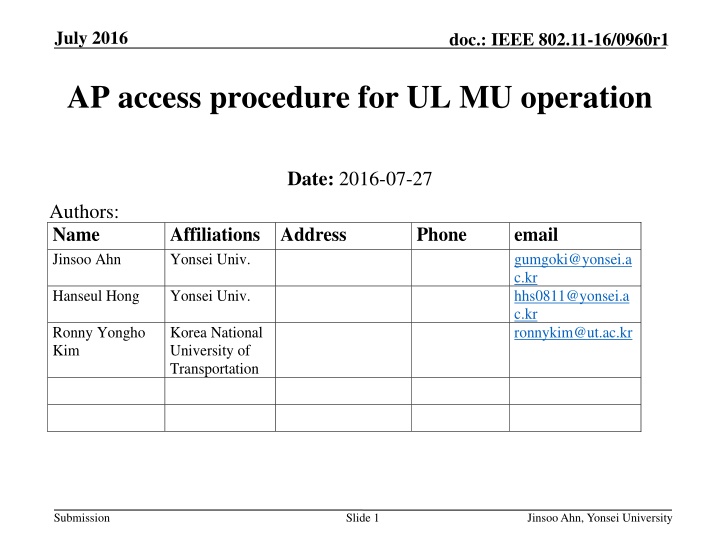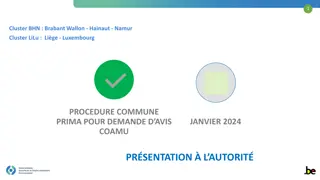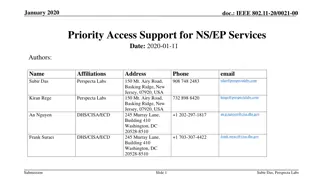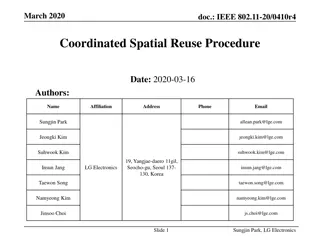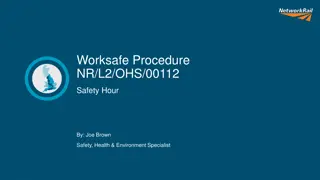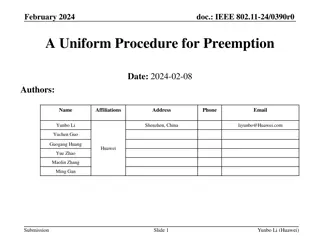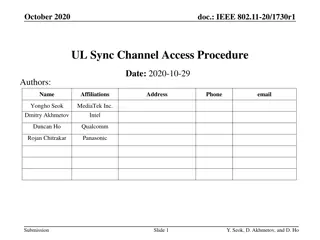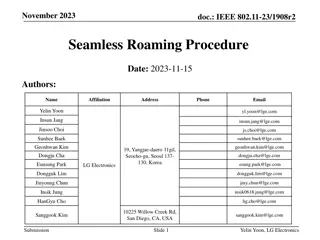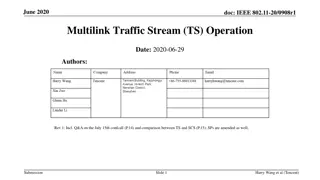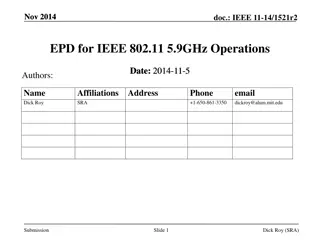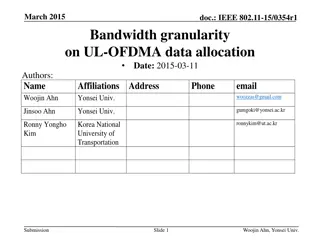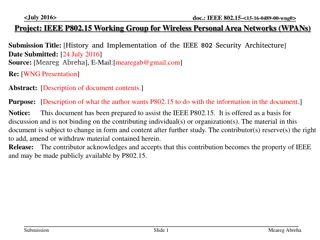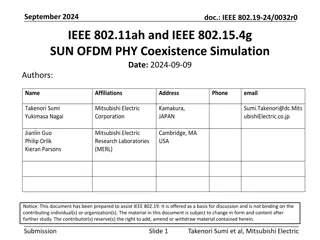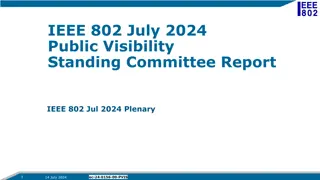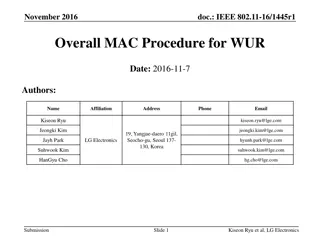IEEE 802.11-16/0960r1 AP Access Procedure for UL MU Operation
This document discusses the AP access procedure for UL MU operation in IEEE 802.11-16/0960r1, focusing on trigger frame transmission, UL transmission decision-making, channel access methods, and legacy 802.11 channel access protocols. It explores the considerations and procedures involved in AP determination, decision-making mechanisms, and priority schemes for accessing the channel.
Download Presentation

Please find below an Image/Link to download the presentation.
The content on the website is provided AS IS for your information and personal use only. It may not be sold, licensed, or shared on other websites without obtaining consent from the author.If you encounter any issues during the download, it is possible that the publisher has removed the file from their server.
You are allowed to download the files provided on this website for personal or commercial use, subject to the condition that they are used lawfully. All files are the property of their respective owners.
The content on the website is provided AS IS for your information and personal use only. It may not be sold, licensed, or shared on other websites without obtaining consent from the author.
E N D
Presentation Transcript
July 2016 doc.: IEEE 802.11-16/0960r1 AP access procedure for UL MU operation Date: 2016-07-27 Authors: Name Jinsoo Ahn Affiliations Address Yonsei Univ. Phone email gumgoki@yonsei.a c.kr hhs0811@yonsei.a c.kr ronnykim@ut.ac.kr Hanseul Hong Yonsei Univ. Ronny Yongho Kim Korea National University of Transportation Submission Slide 1 JinsooAhn, Yonsei University
July 2016 doc.: IEEE 802.11-16/0960r1 Introduction An AP could determine its trigger frame transmission MU UL decision maker determines its UL transmission MU UL decision maker design could be either an implementation issue or a standard issue MU UL decision maker might be related to BSR information After decision making, the AP could transmit trigger frame with several possible solutions of Trigger Frame channel access Depending on logical place and time of decision making, possible procedures vary Trigger Frame channel access is considered in this submission Submission Slide 2 JinsooAhn, Yonsei University
July 2016 doc.: IEEE 802.11-16/0960r1 Channel Access of Legacy 802.11[1] EDCA or DCF (Internal collision in EDCA) DIFS or AIFS sensing time after idle channel sensing DIFS or AIFS + back-off after busy channel sensing Channel Access after SIFS duration Response frames (e.g., Ack frame, CTS, poll, etc.) Subsequent frames of fragment burst Subsequent frames in PSMP sequence PIFS based channel Access TXOP holder s frame after first transmission success in an EDCA TXOP For some management frames (e.g., TIM, PSMP, etc.) PIFS sensing for secondary channels in wideband operation Submission Slide 3 JinsooAhn, Yonsei University
July 2016 doc.: IEEE 802.11-16/0960r1 Channel Access of Trigger Frame An AP could determine access category of Trigger Frame channel access Allow the AP to choose any access category for contending to send the trigger frame The chosen AC may give to the AP higher priority in accessing the channel compared to its associated STAs [2][3] What does Allow the AP to choose any access category for contending to send the trigger frame mean? Specific procedures need to be determined for Trigger Frame Channel Access as legacy 802.11 standards have defined The specific procedures should be specified in 25.5.2.2.3 AP access procedure for UL MU operation of Draft 2.0[4] Submission Slide 4 JinsooAhn, Yonsei University
July 2016 doc.: IEEE 802.11-16/0960r1 Channel Access of Trigger Frame Unclear points regarding Trigger Frame channel access in SFD Does an AP put trigger frame to any queue of chosen AC? (Trigger Frame is considered as a data frame from a channel access point of view) Or does an AP transmit Trigger Frame anytime by using AIFS sensing during TXOP duration of chosen AC? (similar to certain management frames) Or is independent back-off counter needed for Trigger Frame channel access procedure? Is internal contention used for Trigger Frame? (EDCA modification for Trigger Frame channel access) Etc. Submission Slide 5 JinsooAhn, Yonsei University
July 2016 Opt 1. Queue Trigger Frame into queue of determined AC After an AP determined to AC_VO AC_VI AC_BE AC_BK doc.: IEEE 802.11-16/0960r1 Trigger perform UL MU procedure, the AP determines AC of the Trigger Frame and queues the Trigger Frame in the queue of chosen AC STA2 Trigger STA5 STA1 STA2 STA3 STA3 STA1 Backoff AIFS[VO] CW[VO] Backoff AIFS[VI] CW[VI] Backoff AIFS[BE] CW[BE] Backoff AIFS[BK] CW[BK] Virtual Contention [Choose Primary AC] Submission Slide 6 JinsooAhn, Yonsei University
July 2016 Opt 1. Queue Trigger Frame into queue of determined AC doc.: IEEE 802.11-16/0960r1 Easy to implement Trigger Frame channel access could be delayed by accumulated DL data in queue Fairness problems could occur Fairness between DL and UL (If an AP queues too many Trigger Frames in its queues of each ACs) Fairness between HE and Legacy Although fairness problem could be solved by nice implementation, delayed UL MU TXOP is the problem that cannot be solved easily Submission Slide 7 JinsooAhn, Yonsei University
July 2016 Opt 2. xIFS sensing based Trigger Frame transmission Trigger Interrupt by Decision Maker doc.: IEEE 802.11-16/0960r1 AP xIFS Trigger Frame M-BA STA 1 UL PPDU STA 2 UL PPDU STA 3 UL PPDU STAs Sensing time of PIFS or AIFS(Method of selecting AC is TBD) after Trigger Interrupt is required for an AP to transmit a Trigger Frame Submission Slide 8 JinsooAhn, Yonsei University
July 2016 Opt 2. xIFS sensing based Trigger Frame transmission doc.: IEEE 802.11-16/0960r1 Trigger Decision Maker If decision maker decide to transmit a Trigger Frame, an AP stops its EDCA procedure and sense its channel during xIFS duration. If the channel is idle during xIFS, an AP transmits its Trigger Frame without back-off and resumes EDCA N Init Trigger Interrupt? Y Conventional EDCA Stop EDCA procedure for DL transmission Arbitrary AC wins a internal contention Transmits Trigger Frame after xIFS Transmits a PPDU of winning AC Return to EDCA Submission Slide 9 JinsooAhn, Yonsei University
July 2016 Opt 2. xIFS sensing based Trigger Frame transmission doc.: IEEE 802.11-16/0960r1 Give a extremely high priority on Trigger Frame Trigger Frame transmission cannot be harmonized with conventional EDCA procedure AC of Trigger Frame could affect AIFS and TXOP only (no CW value) Fairness problems could occur Fairness between DL and UL Fairness between an AP and non-AP STAs Fairness among BSSs Fairness between HE and Legacy Submission Slide 10 JinsooAhn, Yonsei University
July 2016 Opt 3. Trigger Frame transmission with Separate Back-off procedure Trigger Interrupt by Decision Maker doc.: IEEE 802.11-16/0960r1 AP AIFS Trigger Frame M-BA STA 1 UL PPDU STA 2 UL PPDU STA 3 UL PPDU STAs Similar to AIFS sensing based Trigger Frame transmission but an AP performs back-off procedure based on its AC Method of selecting AC is TBD Submission Slide 11 JinsooAhn, Yonsei University
July 2016 Opt 3. Trigger Frame transmission with Separate Back-off procedure doc.: IEEE 802.11-16/0960r1 Trigger Decision Maker If decision maker decides to transmit a Trigger Frame, an AP stops its EDCA procedure and performs back-off procedure based on its AC of the Trigger Frame After Back-off procedure, AP transmits its Trigger Frame and resumes EDCA N Init Trigger Interrupt? Y Conventional EDCA Stop EDCA procedure for DL transmission Arbitrary AC wins a internal contention Transmits Trigger Frame after xIFS+Back-off Transmits a PPDU of winning AC Return to EDCA Submission Slide 12 JinsooAhn, Yonsei University
July 2016 Opt 3. Trigger Frame transmission with Separate Back-off procedure doc.: IEEE 802.11-16/0960r1 Concept of CSMA/CA is sustained on Trigger Frame transmission AC of Trigger Frame affects its channel access more relatively Trigger Frame transmission cannot be harmonized with conventional EDCA procedure Cannot provide fairness between DL EDCA Frame and Trigger Frame for UL No internal contention between DL EDCA and Trigger Frame Submission Slide 13 JinsooAhn, Yonsei University
July 2016 Opt 4. Winning AC based Trigger Frame transmission Trigger Interrupt by Decision Maker AIFS of DL AC doc.: IEEE 802.11-16/0960r1 AP Trigger Frame (Instead of DL frame) AIFS M-BA STA 1 UL PPDU Back-off of DL AC STA 2 UL PPDU STA 3 UL PPDU STAs After performing conventional EDCA procedure, an AP determines to transmit its DL Frame with winning AC(internal contention winner) or Trigger Frame Submission Slide 14 JinsooAhn, Yonsei University
July 2016 Opt 4. Winning AC based Trigger Frame transmission doc.: IEEE 802.11-16/0960r1 Init After back-off value goes to 0 based on conventional EDCA, Decision Maker decides to transmit its DL frame of winning AC or a Trigger Frame If Decision Maker has decided to transmit a Trigger Frame, a DL frame of winning AC needs to participate in internal contention again Conventional EDCA Arbitrary AC wins a internal contention Trigger Decision Maker N Transmits Trigger instead of a PPDU of winning AC? Y Transmits Trigger Frame Transmits a PPDU of winning AC Submission Slide 15 JinsooAhn, Yonsei University
July 2016 Opt 4. Winning AC based Trigger Frame transmission doc.: IEEE 802.11-16/0960r1 AC of Trigger Frame follows winning AC of DL internal contention Trigger Frame transmission is based on conventional EDCA procedure Cannot provide fairness between DL EDCA Frame and Trigger Frame for UL No internal contention between DL EDCA and Trigger Frame UL MU transmission cannot occur if there are no DL frame in AP queue Submission Slide 16 JinsooAhn, Yonsei University
July 2016 Opt 5. Internal contention based Trigger Frame transmission Trigger Interrupt by Decision Maker doc.: IEEE 802.11-16/0960r1 AP Trigger Frame (with internal contenti on) AIFS AIFS M-BA STA 1 UL PPDU AIFS of MU AC STA 2 UL PPDU Back-off of MU AC STA 3 UL PPDU STAs An AP generates back-off values for Trigger Frame channel access Based on generated back-off values, Trigger Frame contends with other DL frames of conventional ACs to get TXOP Submission Slide 17 JinsooAhn, Yonsei University
July 2016 Opt 5. Internal contention based Trigger Frame transmission doc.: IEEE 802.11-16/0960r1 Init If Decision Maker decide to transmit Trigger Frame, AP generates its Back-off value of Trigger Frame and participates in internal contention When AC of Trigger Frame wins internal contention, AP transmits its Trigger Frame Trigger Decision Maker N Need UL MU? Y Conventional EDCA (Back-off value of 4 ACs) EDCA with AC_MU (Back-off value of 4 ACs+Trigger AC) Arbitrary AC wins a internal contention Transmits a PPDU of winning AC (Trigger Frame Possible) Submission Slide 18 JinsooAhn, Yonsei University
July 2016 Opt 5. Internal contention based Trigger Frame transmission doc.: IEEE 802.11-16/0960r1 Parameters of Trigger Frame AC might follow parameters of conventional ACs Trigger Frame transmission is harmonized with conventional EDCA procedure Provides fairness between DL EDCA Frame and Trigger Frame for UL Immediate Trigger Frame transmission is hardly supported Submission Slide 19 JinsooAhn, Yonsei University
July 2016 doc.: IEEE 802.11-16/0960r1 Conclusions Queueing Trigger Frame in AC queue is simple to implement but there are delay issue related to DL queue If trigger scheduling (decision maker design) is implementation issue, second(xIFS sensing based) and third(Separate Back-off for Trigger Frame) options cannot prevent Trigger Frame Spamming Winning AC based method is not so hard to implement but UL MU cannot be performed if there are no DL data in AP Last option provides a opportunistic scheduling between DL and UL MU but it requires additional virtual EDCAF for UL MU Submission Slide 20 JinsooAhn, Yonsei University
July 2016 doc.: IEEE 802.11-16/0960r1 References [1] Draft P802.11REVmc_D5.0 [2] 11-16/0662r02 Further consideration on channel access rule to facilitate MU transmission opportunity [3] 11-15/0132r17 Spec Framework [4] Draft P802.11ax_D0.2 Submission Slide 21 JinsooAhn, Yonsei University
July 2016 doc.: IEEE 802.11-16/0960r1 Straw poll 1 Do you agree to add the following text to 802.11ax Draft? 25.5.2.2.3 AP access procedure for UL MU operation When the AP intends to acquire a TXOP for transmitting a Trigger frame as an initial frame for UL MU operation, the AP should choose an AC for the Trigger frame transmission and then transmit the Trigger frame using the EDCAF of the chosen AC. Yes No Abstain Submission Slide 22 JinsooAhn, Yonsei University
